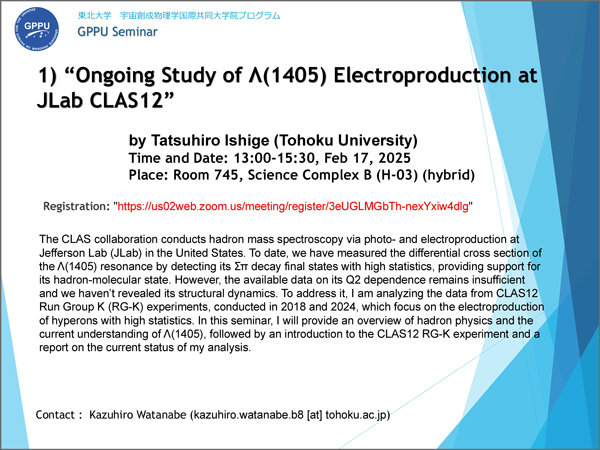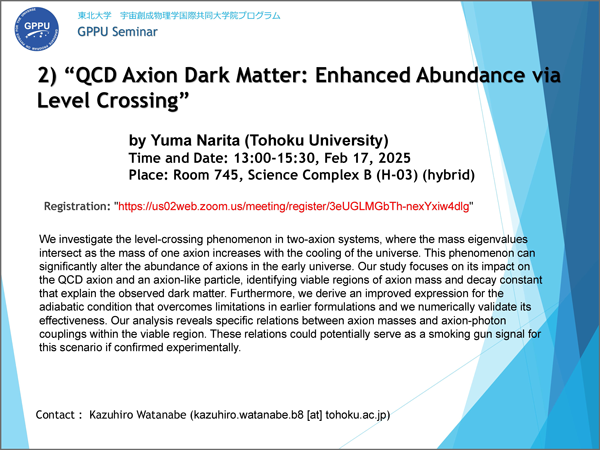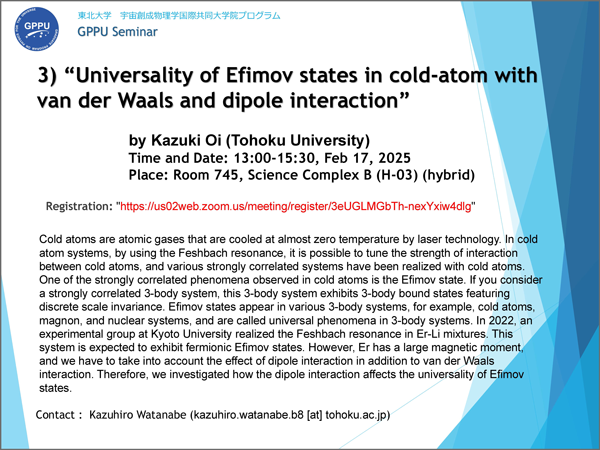お知らせ

- トップ
- お知らせ
GP-PUセミナー開催のご案内
2月17日(月)、以下の内容にて宇宙創成物理学国際共同大学院(GP-PU)セミナーを開催いたします。
■日 時
2025年2月17日(月)13:00-15:30
■セミナー題目
1) Ongoing Study of Λ(1405) Electroproduction at JLab CLAS12
by Tatsuhiro Ishige (Tohoku University)
The CLAS collaboration conducts hadron mass spectroscopy via photo- and electroproduction at Jefferson Lab (JLab) in the United States. To date, we have measured the differential cross section of the Λ(1405) resonance by detecting its Σπ decay final states with high statistics, providing support for its hadron-molecular state. However, the available data on its Q2 dependence remains insufficient and we haven't revealed its structural dynamics. To address it, I am analyzing the data from CLAS12 Run Group K (RG-K) experiments, conducted in 2018 and 2024, which focus on the electroproduction of hyperons with high statistics. In this seminar, I will provide an overview of hadron physics and the current understanding of Λ(1405), followed by an introduction to the CLAS12 RG-K experiment and a report on the current status of my analysis.
2) QCD Axion Dark Matter: Enhanced Abundance via Level Crossing
by Yuma Narita (Tohoku University)
We investigate the level-crossing phenomenon in two-axion systems, where the mass eigenvalues intersect as the mass of one axion increases with the cooling of the universe. This phenomenon can significantly alter the abundance of axions in the early universe. Our study focuses on its impact on the QCD axion and an axion-like particle, identifying viable regions of axion mass and decay constant that explain the observed dark matter. Furthermore, we derive an improved expression for the adiabatic condition that overcomes limitations in earlier formulations and we numerically validate its effectiveness. Our analysis reveals specific relations between axion masses and axion-photon couplings within the viable region. These relations could potentially serve as a smoking gun signal for this scenario if confirmed experimentally.
3) Universality of Efimov states in cold-atom with van der Waals and dipole interaction
by Kazuki Oi (Tohoku University)
Cold atoms are atomic gases that are cooled at almost zero temperature by laser technology. In cold atom systems, by using the Feshbach resonance, it is possible to tune the strength of interaction between cold atoms, and various strongly correlated systems have been realized with cold atoms. One of the strongly correlated phenomena observed in cold atoms is the Efimov state. If you consider a strongly correlated 3-body system, this 3-body system exhibits 3-body bound states featuring discrete scale invariance. Efimov states appear in various 3-body systems, for example, cold atoms, magnon, and nuclear systems, and are called universal phenomena in 3-body systems. In 2022, an experimental group at Kyoto University realized the Feshbach resonance in Er-Li mixtures. This system is expected to exhibit fermionic Efimov states. However, Er has a large magnetic moment, and we have to take into account the effect of dipole interaction in addition to van der Waals interaction. Therefore, we investigated how the dipole interaction affects the universality of Efimov states.
■開催形式
対面×オンライン(Zoom)併用
[対面会場] 理学研究科合同B棟745号室 (キャンパスマップ「H-03」の建物です。)
■参加登録
参加者は事前に下記URLで参加登録が必要です
https://us02web.zoom.us/meeting/register/3eUGLMGbTh-nexYxiw4dlg
■Point
GSP = 1
■お問合せ
物理学専攻(GP-PU) 渡邉 和宏
E-mail: kazuhiro.watanabe.b8[at]tohoku.ac.jp
([at]を@に置き換えてください)



Posted on:2025年2月10日